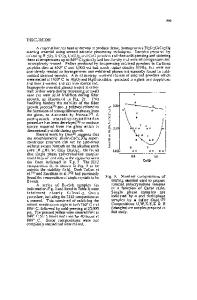Influence of growth parameters on the microstructure of directionally solidified Bi 2 Sr 2 CaCu 2 O y
- PDF / 2,982,218 Bytes
- 16 Pages / 593.28 x 841.68 pts Page_size
- 1 Downloads / 305 Views
H. D. Brodya) University of Pittsburgh, Pittsburgh, Pennsylvania 15261
R. A. Laudiseb) and D.W. Johnson AT&T Bell Laboratories, Murray Hill, New Jersey 07922 (Received 18 January 1990; accepted 29 May 1990) Laser-heated float zone growth was used to study the directional solidification behavior of Bi-Sr-Ca-Cu-O superconductors. The phases that solidify from the melt, their morphology, and their composition are altered by growth rate. Highly textured microstructures are achieved by directional solidification at all growth rates. The superconducting phase is found always to have the composition Bi2.5Sr2CaCu2.2Oj, when grown from boules with composition 2:2:1:2 (BiOi.5:SrO:CaO:CuO). Planar growth fronts of Bi2.5Sr2CaCu2.2Oj, are observed when the temperature gradient divided by the growth rate (G/R) is larger than 3 x 1011 K-s/m2 in 2.75 atm oxygen. Thus, the 2212 compound was observed to solidify directly from the melt at the slowest growth rates used in this study. Measurement of the steady-state liquid zone composition indicates that it becomes bismuth-rich as the growth rate decreases. Dendrites of the primary solidification phase, (Sr1_^Ca^)14Cu24O),, form in a matrix of Bi2.5Sr2CaCu2.2O3, when G/R is somewhat less than 3 x 10u K-s/m2. Observed microstructures are consistent with a peritectic relationship among Bi2.5Sr2CaCu2.2Oj,, (Sri_xCax)i4Cu24Oj, (x = 0.4), and a liquid rich in bismuth at elevated oxygen pressure. At lower values of G/R, Sr3Ca2Cu5Oj, is the primary solidification phase and negligible Bi2.5Sr2CaCu2.2Oj, forms in the matrix.
I. INTRODUCTION
Fabrication of bulk oxide superconductors capable of carrying large amounts of current is a significant technological challenge. A key microstructural requirement to achieving high critical current densities in these materials is known to be the elimination of weak links between grains.1 High-angle grain boundaries have been identified as the cause for granular superconductor behavior in bulk samples of the new oxide superconductors.2'3 Investigators have attempted to modify conventional ceramics processing methods to improve the degree of crystallographic texture in polycrystalline samples of high temperature superconductors. These attempts, however, have not produced the degree of texture found in films deposited on single crystal substrates where an epitaxial relationship between the film and substrate exists. The most promising approaches for improving the current-carrying capacity of bulk materials have ina)Visiting
Professor, Department of gineering, Massachusetts Institute Massachusetts 02139. b)Adjunct Professor, Department of gineering, Massachusetts Institute Massachusetts 02139. 1834
http://journals.cambridge.org
Materials Science and Enof Technology, Cambridge, Materials Science and Enof Technology, Cambridge,
J. Mater. Res., Vol. 5, No. 9, Sep 1990
Downloaded: 17 Mar 2015
volved melt processing because of the highly textured microstructures that are possible. The development of practical techniques for the manufacture of high critical c
Data Loading...











